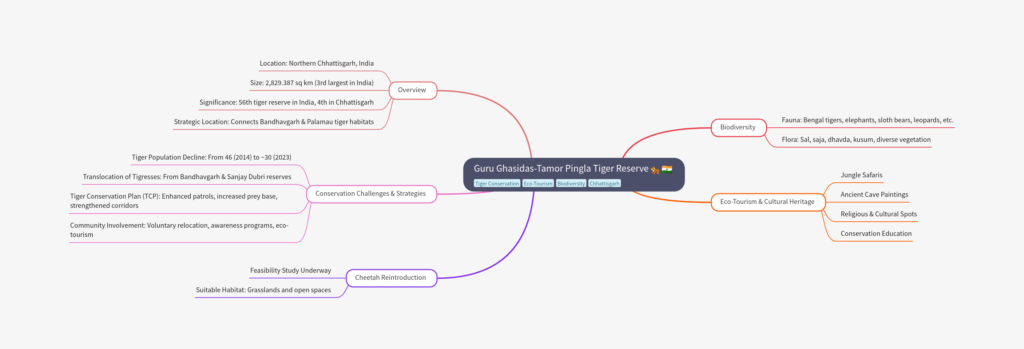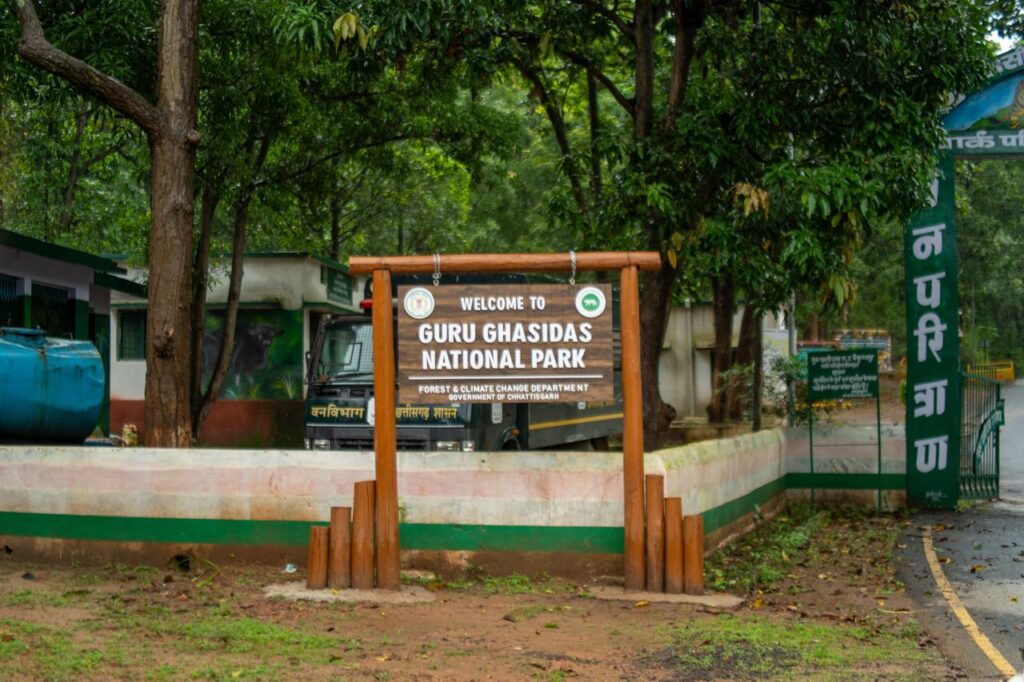Table of Contents

Introduction
India has recently added a new jewel to its crown of wildlife conservation—the Guru Ghasidas-Tamor Pingla Tiger Reserve in Chhattisgarh. Declared as the 56th tiger reserve in India, it marks a significant step forward in preserving and protecting India’s rich biodiversity. This reserve, which is now the fourth tiger reserve in Chhattisgarh, not only plays a pivotal role in tiger conservation but also opens up possibilities for eco-tourism and cheetah reintroduction. This blog takes you through the fascinating aspects of the new reserve, Chhattisgarh’s tiger conservation efforts, and what it means for wildlife enthusiasts and conservationists alike.
Overview of Guru Ghasidas-Tamor Pingla Tiger Reserve

The Guru Ghasidas-Tamor Pingla Tiger Reserve is a vast expanse of wilderness, covering an area of 2,829.387 sq km, making it the third largest tiger reserve in India. It is situated in the northern tribal region of Sarguja and spans across four districts—Manendragarh-Chirmiri-Bharatpur, Korea, Surajpur, and Balrampur. The reserve is strategically located between two significant tiger habitats—Bandhavgarh in Madhya Pradesh and Palamau in Jharkhand. Additionally, it is adjacent to the Sanjay Dubri Tiger Reserve, also in Madhya Pradesh, forming a crucial wildlife corridor for tiger movement.
Rich Wildlife and Ecosystem Diversity
The reserve boasts an impressive variety of flora and fauna, which contributes to its unique ecological significance:
- Fauna: Beyond the majestic Bengal tiger, the reserve is home to numerous species like elephants, sloth bears, leopards, otters, wolves, hyenas, and bison. There’s also a presence of smaller mammals like jackals, langurs, and chitals. The avian population includes vultures, peacocks, and other birds, making it a haven for birdwatchers. The region is particularly noted for its diverse predator-prey dynamics, critical for maintaining a balanced ecosystem.
- Flora: The forests of the reserve are dense and vibrant, featuring a variety of vegetation such as sal, saja, dhavda, and kusum. The landscape is a mix of hills, plateaus, valleys, and rivers, creating diverse habitats that sustain its rich wildlife. This varied terrain provides ideal conditions for the movement and habitat of tigers and other species.
The Conservation Challenge in Chhattisgarh
Chhattisgarh’s tiger population has seen a worrying decline over the years. In 2014, the state reported 46 tigers, which dropped significantly to 17 by 2022, as per the National Tiger Conservation Authority (NTCA) report of 2023. Currently, the state has about 30 tigers, with five to six residing in the new reserve. This sharp decline has prompted authorities to take urgent measures to stabilize and boost the tiger numbers.
How Authorities Plan to Boost the Tiger Population
To revitalize the tiger population in Chhattisgarh, several strategies are being implemented:
- Translocation of Tigresses: There are plans to introduce tigresses from Madhya Pradesh’s Bandhavgarh and Sanjay Dubri reserves to balance the gender ratio and encourage breeding.
- Tiger Conservation Plan (TCP): A comprehensive Tiger Conservation Plan is being formulated to tackle various challenges. The plan involves:
- Enhancing patrol and monitoring through better road and wireless connectivity in the reserve’s hilly regions.
- Increasing the prey base by developing grasslands, water sources, and translocating animals like cheetal and wild boars to the reserve.
- Strengthening wildlife corridors to facilitate natural tiger migration between reserves in Madhya Pradesh and Chhattisgarh.
- Building good relations with local communities to reduce human-wildlife conflicts.
Community Involvement and Mitigating Human-Wildlife Conflict
The reserve includes 42 villages, most of which are sparsely populated. To minimize conflicts between humans and wildlife, several measures are being taken:
- Voluntary Relocation: Villagers have the option to relocate voluntarily, and they are given priority for jobs within the reserve, such as working as guides, managing homestays, or in eco-tourism ventures.
- Wildlife Awareness Programs: Authorities are educating local communities about the importance of conservation and strategies to avoid potential conflicts with wildlife.
- Eco-Tourism Opportunities: Efforts are underway to develop an eco-tourism circuit in the region, creating sustainable livelihood options for residents.
Eco-Tourism and Cultural Heritage
The Chhattisgarh government is not just focusing on conservation but also on making the reserve a prime destination for eco-tourism. Plans include:
- Jungle Safaris: Infrastructure is being developed to support guided safaris that allow visitors to explore the rich biodiversity of the reserve.
- Ancient Cave Paintings: The region has eight sites with ancient cave paintings that are being preserved and promoted as part of the tourism circuit.
- Religious and Cultural Spots: Religious sites, river walks, and viewpoints like Balam Ghat are being enhanced to attract a diverse group of tourists.
- Conservation Education: Tourists will be educated about the importance of tiger conservation, providing a comprehensive wildlife experience.
Reintroducing Cheetahs: A Historic Step

The last sighting of a cheetah in this region was in the 1940s, but the new reserve brings hopes of reintroducing the species in Chhattisgarh. The state is exploring the feasibility of reintroduction, which would be a historic step in reviving the cheetah population in India. The diverse habitat of Guru Ghasidas-Tamor Pingla, with its vast grasslands and open spaces, is considered suitable for supporting a small population of cheetahs.
What’s Next for Guru Ghasidas-Tamor Pingla?
The future of the Guru Ghasidas-Tamor Pingla Tiger Reserve looks promising with a well-planned approach to conservation, community involvement, and tourism development. The success of this initiative could set an example for other states struggling with wildlife conservation challenges. The combination of preserving ancient culture, protecting biodiversity, and empowering local communities is a holistic model that could drive sustainable conservation efforts.
FAQs
Q1: Why is the Guru Ghasidas-Tamor Pingla important for tiger conservation?
Ans: The reserve plays a critical role in connecting tiger habitats between Madhya Pradesh and Jharkhand, serving as a crucial wildlife corridor for natural tiger movement and breeding.
Q2: In which state is the Guru Ghasidas-Tamor Pingla Tiger Reserve located?
Ans: The Guru Ghasidas-Tamor Pingla Tiger Reserve is located in the state of Chhattisgarh, India, specifically in the northern tribal region of Sarguja.
Q3: What wildlife can be spotted in the reserve?
Ans: Apart from tigers, the reserve is home to elephants, leopards, sloth bears, wolves, hyenas, otters, and a variety of bird species, including vultures and peacocks.
Q4: What steps are being taken to increase the tiger population?
Ans: Authorities are translocating tigresses, developing a comprehensive conservation plan, enhancing prey availability, and strengthening wildlife corridors to boost the tiger population.
Q5: How are local communities being involved in conservation efforts?
Ans: Local villagers are given opportunities to relocate voluntarily, are prioritized for employment within the reserve, and are being trained for tourism-related roles like guides and homestay operators.
“I appreciate the detailed explanation, very helpful!”
“This post has helped me solve my issue, thanks a ton!”